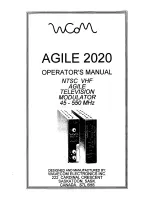
Programming 16-15
8316PROG.DOC TI-83 international English Bob Fedorisko Revised: 02/19/01 1:23 PM Printed: 02/19/01 1:39
PM Page 15 of 22
Use
prgm
to execute other programs as subroutines (page
16
.
22). When you select
prgm
, it is pasted to the cursor
location. Enter characters to spell a program
name
. Using
prgm
is equivalent to selecting existing programs from the
PRGM EXEC
menu; however, it allows you to enter the
name of a program that you have not yet created.
prgm
name
Note: You cannot directly enter the subroutine name when using
RCL
.
You must paste the name from the
PRGM EXEC
menu (page 16
.
7).
Return
quits the subroutine and returns execution to the
calling program (page 16
.
22), even if encountered within
nested loops. Any loops are ended. An implied
Return
exists at the end of any program that is called as a
subroutine. Within the main program,
Return
stops
execution and returns to the home screen.
Stop
stops execution of a program and returns to the home
screen.
Stop
is optional at the end of a program.
DelVar
deletes from memory the contents of
variable
.
DelVar
variable
GraphStyle(
designates the style of the graph to be drawn.
function#
is the number of the
Y=
function name in the
current graphing mode.
graphstyle
is a number from
1
to
7
that corresponds to the graph style, as shown below.
1
=
ç
(line)
5
=
ë
(path)
2
=
è
(thick)
6
=
ì
(animate)
3
=
é
(shade above)
7
=
í
(dot)
4
=
ê
(shade below)
GraphStyle(
function#
,
graphstyle
)
For example,
GraphStyle(1,5)
in
Func
mode sets the graph
style for
Y
1
to
ë
(path;
5
).
Not all graph styles are available in all graphing modes. For
a detailed description of each graph style, see the Graph
Styles table in Chapter 3.
prgm
Return
Stop
DelVar
GraphStyle(
















































